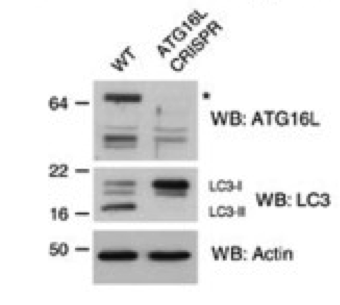This is a knockout-validated antibody summary, based on the publication "The Parkinson's disease-associated genes ATP13A2 and SYT11 regulate autophagy via a common pathway", as cited below [1]. Labome curates formal publications to compile a list of antibodies with unambiguous specificity within Validated Antibody Database (VAD).

Rabbit polyclonal
Company: MBL
Antibody: ATG16L
Catalog number: PM040
Summary: Rabbit polyclonal antibody raised against recombinant human ATG16L1 TV2, residues 85-588.
Antibody is affinity purified.
Supplier recommended for ICC, IP and WB.
Reacts with hamster, human, mouse and rat ATG16L.
Western blot
Wild-type and ATG16L -/- Hela cell lysates.
PBS containing 5% milk powder and 0.2% Tween 20.
1:1000 overnight at 4oC.
1:2000 with HRP-conjugated anti-rabbit IgG (NA934V; GE Healthcare) for 1 hour at room temperature.
ECL Reagent (Pierce).
Image J software for data capture and densitometry.
If the antibody described in this summary is a polyclonal antibody, since polyclonal antibodies are of limited quantity, please inquire the supplier whether any current polyclonal antibody with the same catalog number is exactly the same as the one described in this summary. Sometimes, different bleeds or different animals are used, usually with a different lot number. In such cases, the result in this summary may not apply to the new antibody with the same catalog number.
- If you are aware of any publication with knockout studies validating a monoclonal or recombinant antibody, either purchased from a supplier or developed by the author(s), please notify us through feedback.
- geneproduct
